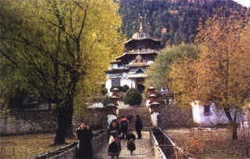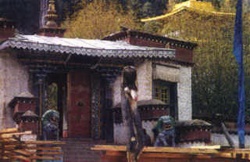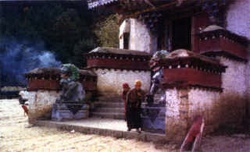Reproductive Organs Worshipped in the Lamaling Monastery
The Lamaling Monastery was built for worshippers of the Lhoba ethnic group. It is of the Nyingma Sect. A shot of the Lamaling Monastery in Nyingchi.
The Nyingma Sect retains many signs of the Bon Religion. Historically, the 27 Tubo kings from Nytri Tsangpo to Lhatog Tori Nyitsang, took the Bon Religion as the Tubo Religion. When Buddhism spread into Tubo, the Bon Religion lost favor of worshippers, and finally was reduced into a sect of Tibetan Buddhism. Many worshippers of the Bon Religion fled to Gongbo and other remote areas in eastern Tibet. This is why the Bon Religion still is a major Religion there.
The Bon Religion worships the nature and believes that all things living have souls. So, they worship the reproductive organs.
The Bon Religion is strongly influential among the Lhoba and Moinba peoples in the Yarlung Zangbo River Grand Canyon area. This is why they planted specimen of reproductive organs even at home or in the fields.
The Lamaling Monastery, located in a mountain valley skirted by the Nyang Qu River, is only 30 km away from the Bayi Town, site of the government of the Nyingchi Prefecture.
I went there by car. In half an hour, I reached Zholmo Village in Burqug Township, where I turned to the Burqug Gully. Before long, I noticed two glistening building shaded in green Trees.
In front of the Lamaling Monastery is an open land, with an extended Path leading to the Monastery. Flanking the long Path are civilian houses surrounded by poplar and peach Trees. Reproductive organs for man and woman displayed in front of the gate to the Lamaling Monastery.
In the Monastery square there stands a Tree root carved in the shape of the lower part of a man. It stands two meters high, with two thin legs forming an inverted “V”. On top of the inverted V there protrudes a Penis covered in the upper part with “Hair”, which measures 80-90 cm long and 35 cm thick. It takes the red color and is coated with butter. The wooden Penis even has Hair on the upper part.
In between the Tree root carving and the Monastery gate, there stand five poles with fluttering Sutra streamers.
Above the Monastery gate is a horizontal board inscribed with “Burqug Township Lamaling Monastery”.
Flanking the gate are two squatting lions.
On the Right part of the foundation is a protruding Penis, which, Measuring 90 cm long and 20 cm in diameter, is coated in red. On the left foundation is the lower part of female Body, with splitting legs to show the red pudenda. According to lamas with the Monastery, when women come, they would touch the wooden Penis as a token of worship.
Inside the Monastery were two giant Prayer tubes. All worshippers turn them in a clockwise Way.
I followed the worshippers to the Main Hall, which houses the statue of Sakyamuni, founder of Buddhism....
Reproductive organs for man and woman displayed in front of the gate to the Lamaling Monastery.
WORSHIPPING REPRODUCTIVE ORGANS
Worshipping reproductive organs happened only in the primitive period. And one learns this only from Books. Recently, however, I found such a kind of worship during our visit to the Yarlung Zangbo River Grand Canyon. When I got there, I was attracted by and astonished to see specimen of reproductive organs by the Monastery gates. Reproductive organs for man and woman displayed in front of the gate to the Lamaling Monastery.
During my visit to areas inhabited by people of the Moinba and Lhoba ethnic groups in Medog County, I was amazed to see the display of the reproductive organs in villages and fields.
Reproductive organs were also worshipped in the Lamaling Monastery in Burqug Township, Nyingchi County.


